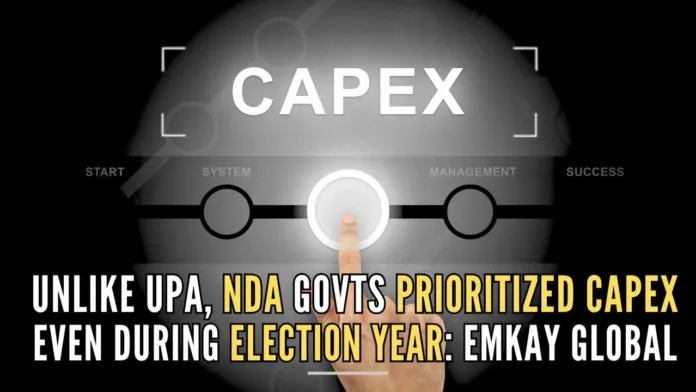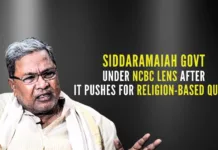
Emkay Global says tendency of policymakers to be pro-cyclical around election cycles has become more efficient
Even when it is an election year, the BJP-led National Democratic Alliance (NDA) government prioritized capital expenditure (capex) and asset creation over revenue expenditure (revex), a top economist at Emkay Global Financial Services Ltd said in a research report.
“Election cycles where the NDA has been the incumbent have seen capex prioritized over revex, with current cycle trends being even stronger vs previous cycles,” said Madhavi Arora, Lead Economist, in a report analyzing the five election cycles since 2004.
While the NDA government under the regime of late Prime Minister Atal Bihari Vajpayee had higher capex compulsions, as the private sector was warming up to lead the capex cycle from 2005 onwards, the current Prime Minister Narendra Modi-led era has been doing the same for bringing back the missing private sector, the report said.
The UPA government under Manmohan Singh, on the contrary, enjoyed dividends of the past policies plus the first leg of the private capex rally, but on the net, ended up deprioritizing capex over revex – more during election years than non-election years.
This trend has been extrapolated across UPA-led states pre-elections, while NDA-led states have, on an average, an improving mix of capex/ revex, especially during election years (average of 19.4 percent vs about 18 percent pre-elections), the report states.
The effect of a strong political mandate on economic policy is apparent even when the incumbent has retained power but with the stronger majority.
The present NDA regime’s school of thought has been supply-side driven which has only strengthened in their second (current) term, as power consolidation at central and state levels favoured them further ahead of the 2024 elections, Arora said in the report.
According to the report, the NDA-II under Modi has maintained significant frontloading of capex in an election year – 59 percent of the Budget Estimates (despite a lofty budgeted capex target of Rs.10 trillion) vs UPA’s 10-year average of 48 percent (UPA-II: about 50 percent).
The election year capex/ revex mix has dramatically improved in NDA-II vs I, as against UPA-II vs I, where the mix worsened amid UPA II losing political popularity, the report said.
Interestingly, macro compulsions had meant healthy fiscal consolidation in 2013 during the UPA-II regime, but it came at the cost of capex (FY14 capex/ GDP stayed at the lows of 1.7 percent).
NDA-II’s election year capex/ GDP is 1.3 times the average of its non-election years, while revex/ GDP is about 25 percent lower than the average of non-election years, with better sectoral allocations, the report said.
According to Arora, the study of the last five election cycles indicates that in general, barring a global financial crisis (GFC), Central governments have been consolidating in the year just preceding an election, regardless of political affiliation, with lower fiscal deficits/ gross domestic product (GDP) than in the previous three years.
This is true at an aggregate level as well (Centre and states). While the NDA government prioritized capex over revex especially in the current cycle (FY24; capex/GDP: 3.3 percent vs 2.5 percent average for previous three years), when the party seems to be assured of returning to power and, therefore, the need for wooing voters via fiscal populism has reduced, the report notes.
“In contrast, the two cycles where the UPA was in power (FY09 and FY14) saw capex/ GDP decline when compared with the previous three years (FY09: 1.6 percent vs 2 percent average prior three years; FY14: 1.7 percent vs 1.8 percent average prior three years).
“Average capex/ GDP has also, by and large, been higher under NDA governments, regardless of whether it is an election year or not (NDA average: 2.3 percent vs UPA average: 2 percent),” the report said.
“While revex/ GDP has generally been lower in all election years in comparison with prior years (with the exception of FY09 due to the impact of Pay Commission, higher MGNREGA payouts, and GFC), UPA governments have tended to spend more on revex, on average, than NDA governments, during election years. The quality of expenditure, i.e. the mix of capex/ revex has been healthier in all the three NDA regimes vs UPA-I and II as well,” the report said.
“The stickiness of sharp increase in subsidies bill during UPA-I regime (2.2 percent of GDP in FY09 – before the general elections, continued to hurt the exchequer through their second stint between FY09-13 and added to economic inefficiency. ”
[With Inputs from IANS]
For all the latest updates, download PGurus App.








